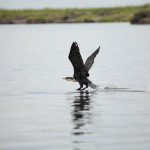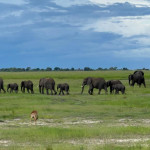Discover fascinating facts about Zimbabwe before your next trip! From ancient ruins to wildlife, learn about its rich culture, history, and natural beauty.
Here are 83 interesting facts about Zimbabwe that might be useful for travelers:
1. Zimbabwe is a landlocked country located in southern Africa.
2. The country is known for its stunning natural beauty, including Victoria Falls, one of the world's largest waterfalls.
3. Zimbabwe is home to a diverse range of wildlife, including elephants, lions, leopards, and rhinoceroses.
4. The country has a population of around 14 million people.
5. The official languages of Zimbabwe are English, Shona, and Ndebele.
6. The currency of Zimbabwe is the Zimbabwean dollar, although the US dollar is widely used as well.
7. Zimbabwe gained independence from Britain in 1980.
8. The country is named after the ancient Kingdom of Zimbabwe, which existed between the 11th and 15th centuries.
9. Zimbabwe is known for its rich cultural heritage, including traditional dance, music, and art.
10. The country has a warm, subtropical climate with a rainy season from November to March.
11. Zimbabwe is home to several national parks and game reserves, including Hwange National Park, Mana Pools National Park, and Matobo National Park.
12. The Great Zimbabwe Ruins, located near the town of Masvingo, are a UNESCO World Heritage Site.
13. Zimbabwe is famous for its high-quality diamonds, which are among the largest and most valuable in the world.
14. The country is also known for its rich deposits of gold, platinum, and other minerals.
15. The Shona people are the largest ethnic group in Zimbabwe, followed by the Ndebele.
16. Zimbabwe has a diverse range of traditional foods, including sadza (a kind of porridge made from maize meal), muriwo unedovi (vegetables cooked with peanut butter), and bota (a type of bread made from maize meal).
17. The country has a vibrant music scene, with genres ranging from traditional mbira music to contemporary hip hop.
18. Zimbabwe has a literacy rate of around 90%, one of the highest in Africa.
19. The country has a well-developed education system, with several universities and colleges offering a wide range of courses.
20. Zimbabwe's economy is heavily reliant on agriculture, with maize, tobacco, cotton, and sugar being major crops.
21. Zimbabwe has a rich history of political activism, with figures such as Joshua Nkomo and Robert Mugabe playing prominent roles in the country's struggle for independence.
22. The Zimbabwean flag features seven horizontal stripes of green, yellow, red, black, red, yellow, and green, with a white triangle on the left-hand side and a depiction of the Great Zimbabwe Ruins in the center.
23. Zimbabwe is home to several prominent musicians, including Thomas Mapfumo, Oliver Mtukudzi, and Jah Prayzah.
24. The country has several traditional festivals and ceremonies, including the Harare International Festival of the Arts (HIFA) and the Zimbabwe International Book Fair.
25. Zimbabwe has a well-developed transport infrastructure, with several airports, highways, and railways connecting major cities and towns.
26. The country's capital city is Harare, which has a population of around 1.6 million people.
27. Other major cities in Zimbabwe include Bulawayo, Mutare, Gweru, and Masvingo.
28. Zimbabwe has a rich history of art and craftsmanship, with traditional crafts such as basket weaving, pottery, and woodcarving still practiced today.
29. The country has a diverse range of landscapes, including mountains, forests, savannas, and wetlands.
30. Zimbabwe has a number of lakes and rivers, including Lake Kariba and the Zambezi River.
31. Zimbabwe has a rich history of mining, with gold being discovered in the country as early as the 13th century.
32. The country's national football team is nicknamed the Warriors.
33. Zimbabwe has a rich literary tradition, with writers such as Dambudzo Marechera, Yvonne Vera, and Chenjerai Hove gaining international recognition.
34. The country has a number of historic sites, including the ruins of the ancient city of Khami and the Chinhoyi Caves.
35. Zimbabwe has a diverse range of religions, including Christianity, Islam, and traditional African religions.
36. The country's national bird is the bateleur eagle.
37. Zimbabwe has a number of traditional healing practices, including the use of herbs, massage, and spiritual healing.
38. The country has a well-developed tourism industry, with visitors coming from all over the world to see its natural beauty and cultural attractions.
39. Zimbabwe has a rich history of sculpture, with artists such as Dominic Benhura and Nicholas Mukomberanwa gaining international acclaim.
40. The country has several game reserves and conservancies dedicated to the protection of endangered species such as the black rhinoceros.
41. Zimbabwe has a richhistory of struggle against colonialism and apartheid, with figures such as Nelson Mandela and Robert Mugabe playing prominent roles in the fight for African liberation.
42. The country is known for its friendly people and welcoming culture, with visitors often remarking on the warmth and hospitality of Zimbabweans.
43. Zimbabwe has a number of traditional sports, including soccer, rugby, and cricket.
44. The country has a well-developed healthcare system, with several hospitals and clinics providing medical care to the population.
45. Zimbabwe has a number of historic buildings and landmarks, including the National Heroes Acre and the Parliament of Zimbabwe.
46. The country has a rich history of oral storytelling, with traditional tales and legends being passed down from generation to generation.
47. Zimbabwe has a number of traditional dances, including the mbira dance and the Jerusarema dance.
48. The country has a number of traditional instruments, including the mbira (thumb piano), the marimba (xylophone), and the hosho (rattle).
49. Zimbabwe has a number of traditional crafts, including basket weaving, pottery, and carving.
50. The country has a number of traditional dress styles, including the chitenge and the shweshwe.
51. Zimbabwe has a number of traditional foods, including sadza, muriwo unedovi, and bota.
52. The country has a number of traditional drinks, including chibuku (a type of beer made from maize meal) and maheu (a type of fermented drink made from maize).
53. Zimbabweans are known for their love of music and dance, with many traditional events featuring live performances by local musicians and dancers.
54. Zimbabwe has a number of traditional games, including bao (a type of board game) and mancala (a type of stone game).
55. The country has a number of traditional beliefs and superstitions, including the belief in ancestral spirits and the power of traditional healers.
56. Zimbabwe has a number of traditional festivals and ceremonies, including the Harare Agricultural Show and the Zimbabwe International Trade Fair.
57. The country has a number of traditional crafts markets, including the Mbare Musika Market in Harare.
58. Zimbabwe has a number of traditional hunting practices, including bow hunting and hunting with dogs.
59. The country has a number of traditional farming practices, including the use of ox-drawn plows and the cultivation of small-scale vegetable gardens.
60. The country has a number of traditional housing styles, including mud huts, thatched-roof houses, and brick houses.
61. Zimbabwe has a number of traditional transportation methods, including ox carts, bicycles, and donkey-drawn carts.
62. The country has a number of traditional medicinal plants, including the mupfuti tree (used to treat malaria) and the muti tree (used to treat various ailments).
63. Zimbabwe has a number of traditional wedding customs, including the payment of a bride price and the exchange of gifts between families.
64. The country has a number of traditional family structures, including extended families and polygamous marriages.
65. Zimbabwe has a number of traditional environmental practices, including the use of natural fertilizers and the conservation of natural resources.
66. The country has a number of traditional hunting and fishing grounds, including the Zambezi River and Lake Kariba.
67. Zimbabwe has a number of traditional storytelling methods, including the use of songs, dances, and proverbs.
68. Zimbabwe has a number of traditional art forms, including painting, sculpture, and basket weaving.
69. The country has a number of traditional musical instruments, including the mbira, the marimba, and the hosho.
70. Zimbabwe has a number of traditional dance styles, including the Jerusarema dance and the mbira dance.
71. The country has a number of traditional cultural centers, including the National Gallery of Zimbabwe and the National Arts Council of Zimbabwe.
72. Zimbabwe has a number of traditional sports teams, including the Zimbabwe national soccer team and the Zimbabwe national cricket team.
73. The country has a number of traditional cuisines, including Shona cuisine and Ndebele cuisine.
74. Zimbabwe has a number of traditional drinks, including chibuku and maheu.
75. The country has a number of traditional desserts, including rice pudding and pumpkin pie.
76. Zimbabwe has a number of traditional condiments, including peanut butter and hot sauce.
77. The country has a number of traditional vegetables, including okra and pumpkin.
78. Zimbabwe has a number of traditional fruits, including mangoes and papayas.
79. The country has a number of traditional grains, including maize and millet.
80. Zimbabwe has a number of traditional herbs and spices, including ginger and garlic.
81. The country has a number of traditional sweets, including fudge and toffee.
82. Zimbabwe has a number of traditional snacks, including roasted peanuts and biltong (dried meat).
83. The country has a number of traditional drinks, including tea




